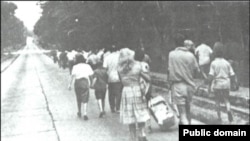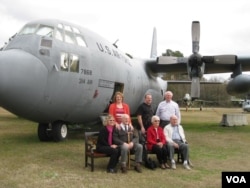WARNER ROBINS, GEORGIA —
A gray Hercules C-130E military transport plane sits outside the National Aviation Museum in Warner Robins, Georgia, its flying days over. With its fading paint, it's hard to imagine the plane was once at the center of an international hostage drama.
In August 1964, in the central African country known today as the Democratic Republic of Congo, a militant rebel group called the Simbas seized nearly 2,000 U.S. and European citizens, many of them missionaries, and held them hostage in Stanleyville, a city they had just taken from government soldiers.
On November 24 of that year, Belgian and American military forces mounted a dramatic airborne mission to rescue the hostages and crush the Simba rebellion. Though the mission succeeded, dozens of hostages were killed by the rebels before they could be freed.
Now, 48 years later, six of those airlifted to safety on the plane returned to see it and to meet its pilot for the first time.
Mack Secord, now 81, was the 35-year-old pilot of the C-130 on November 24, 1964, when the missionaries and their children were rescued from Stanleyville.
"I’m sorry I didn’t have a chance to come back and welcome you aboard in Stanleyville," he said to the group, "but we were a little busy."
Busy is an understatement. His airplane was part of a squadron of a dozen C-130s on a secret mission to end the rebellion and rescue more than 1800 hostages.
"The first six airplanes had the Belgian para-commandos, and they were going to drop them onto the airport and clear off all that garbage that the Simbas had put on the runway - the 55-gallon [208-liter] drums filled with water and the old car bodies and so forth," Secord said. "We were going to come in and land and offload ammunition and supplies. My instructions were to get there, park, but don’t shut off the engines, because we expected you in 30-to-45 minutes. Well, it was about two hours, and we were worried about fuel."
About 100 former hostages were loaded into the plane’s cargo hold, including Bob McAllister, now 87, who came to the reunion with his daughter, Ruth.
"The whole side there and the side here lined with people being rescued," said McAllister, who'd been a missionary in the Congo for a dozen years. "And, on the center isle here, they had stretchers of some of the wounded people, and so we were a crowded bunch here."
As the plane took off, Secord looked out the cockpit window.
"As we taxied out with you all on board, the Simbas leaped out of the tall grass next to the taxiway," he said, "and they shot straight up and they shot into this wing over here."
And punctured the fuel tank. Secord, afraid the leaking fuel would catch fire, shut down the engine. With only three engines, and low on fuel, he still managed to fly the freed hostages to safety.
Newsreels of the airlift appeared in theaters across the U.S. and Britain. Life Magazine ran an article about it. Eventually, the pilot and the former hostages moved on with their lives.
Secord retired from the Air Force and became a businessman. The rescued hostages continued their careers as missionaries. Neither they, nor Secord, gave thought much about the airlift, until last year.
Secord got a call from an old Air Force friend, the director of the National Aviation Museum. The museum had received a retired C-130, and the plane’s maintenance records showed that it had been damaged in combat in the Congo in November 1964. His friend was sure it was Secord’s plane.
When the plane was formally put on display at the museum, Secord attended the dedication ceremony. The story about a pilot being reunited with his airplane was reported in the local newspaper and republished on the Internet. That’s how Marilyn Wendler, who was just 4 years old at the time of the rescue, heard about it.
"When we read the bio of the plane and it said that it had had a fuel tank hit on takeoff, some of our group remembered that," she said. "And so we were like this must be the airplane."
Wendler called the museum, got Secord’s telephone number, and arranged a reunion.
"Who would have thought? This is 48 years have gone by," Wendler said. "We kind of stopped thinking about it. And now it’s all revived, so it's amazing. I remember walking in the back end of this huge airplane, sitting on the side in a hammock seat just really happy that the U.S. government came and got us, that the U.S. Air Force was there."
Secord is happy, too.
"I’ve never seen these people before. I was sitting in the seat with the engines running," he said. "I had no idea that someday I’d be reacquainted with some of the passengers. It is a real thrill to be with some of them."
For the C-130, it’s the second time the plane has united the pilot with the people he helped save.
In August 1964, in the central African country known today as the Democratic Republic of Congo, a militant rebel group called the Simbas seized nearly 2,000 U.S. and European citizens, many of them missionaries, and held them hostage in Stanleyville, a city they had just taken from government soldiers.
On November 24 of that year, Belgian and American military forces mounted a dramatic airborne mission to rescue the hostages and crush the Simba rebellion. Though the mission succeeded, dozens of hostages were killed by the rebels before they could be freed.
Now, 48 years later, six of those airlifted to safety on the plane returned to see it and to meet its pilot for the first time.
Mack Secord, now 81, was the 35-year-old pilot of the C-130 on November 24, 1964, when the missionaries and their children were rescued from Stanleyville.
"I’m sorry I didn’t have a chance to come back and welcome you aboard in Stanleyville," he said to the group, "but we were a little busy."
Busy is an understatement. His airplane was part of a squadron of a dozen C-130s on a secret mission to end the rebellion and rescue more than 1800 hostages.
"The first six airplanes had the Belgian para-commandos, and they were going to drop them onto the airport and clear off all that garbage that the Simbas had put on the runway - the 55-gallon [208-liter] drums filled with water and the old car bodies and so forth," Secord said. "We were going to come in and land and offload ammunition and supplies. My instructions were to get there, park, but don’t shut off the engines, because we expected you in 30-to-45 minutes. Well, it was about two hours, and we were worried about fuel."
About 100 former hostages were loaded into the plane’s cargo hold, including Bob McAllister, now 87, who came to the reunion with his daughter, Ruth.
"The whole side there and the side here lined with people being rescued," said McAllister, who'd been a missionary in the Congo for a dozen years. "And, on the center isle here, they had stretchers of some of the wounded people, and so we were a crowded bunch here."
As the plane took off, Secord looked out the cockpit window.
"As we taxied out with you all on board, the Simbas leaped out of the tall grass next to the taxiway," he said, "and they shot straight up and they shot into this wing over here."
And punctured the fuel tank. Secord, afraid the leaking fuel would catch fire, shut down the engine. With only three engines, and low on fuel, he still managed to fly the freed hostages to safety.
Newsreels of the airlift appeared in theaters across the U.S. and Britain. Life Magazine ran an article about it. Eventually, the pilot and the former hostages moved on with their lives.
Secord retired from the Air Force and became a businessman. The rescued hostages continued their careers as missionaries. Neither they, nor Secord, gave thought much about the airlift, until last year.
Secord got a call from an old Air Force friend, the director of the National Aviation Museum. The museum had received a retired C-130, and the plane’s maintenance records showed that it had been damaged in combat in the Congo in November 1964. His friend was sure it was Secord’s plane.
When the plane was formally put on display at the museum, Secord attended the dedication ceremony. The story about a pilot being reunited with his airplane was reported in the local newspaper and republished on the Internet. That’s how Marilyn Wendler, who was just 4 years old at the time of the rescue, heard about it.
"When we read the bio of the plane and it said that it had had a fuel tank hit on takeoff, some of our group remembered that," she said. "And so we were like this must be the airplane."
Wendler called the museum, got Secord’s telephone number, and arranged a reunion.
"Who would have thought? This is 48 years have gone by," Wendler said. "We kind of stopped thinking about it. And now it’s all revived, so it's amazing. I remember walking in the back end of this huge airplane, sitting on the side in a hammock seat just really happy that the U.S. government came and got us, that the U.S. Air Force was there."
Secord is happy, too.
"I’ve never seen these people before. I was sitting in the seat with the engines running," he said. "I had no idea that someday I’d be reacquainted with some of the passengers. It is a real thrill to be with some of them."
For the C-130, it’s the second time the plane has united the pilot with the people he helped save.






